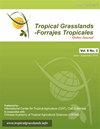Dry matter yields and quality parameters of ten Napier grass (Cenchrus purpureus) genotypes at three locations in western Oromia, Ethiopia
IF 0.7
4区 农林科学
Q3 AGRICULTURE, DAIRY & ANIMAL SCIENCE
引用次数: 2
Abstract
Ten Napier grass genotypes (accessions) were assessed across 3 locations, Bako, Boneya Boshe and Gute, for forage dry matter (DM) yield, crude protein (CP) concentration, leaf:stem ratio, nutrient composition and digestibility characteristics during 2016 and 2017. The genotypes were evaluated in a randomized complete block design with 3 replications. Mean DM yield was higher for accession ILRI 16804 across all locations followed by ILRI 16801 and ILRI 16800. Leaf:stem ratio, CP concentration and CP and digestible organic matter (OM) yields also varied significantly among genotypes with the highest values obtained for accession ILRI 16804 across all locations, followed by ILRI 16800 and ILRI 16801. Yields of DM, CP and digestible OM and leaf:stem ratio were higher at Boneya Boshe and Gute than at Bako and higher during 2017 than during 2016. The consistently superior performance of ILRI 16804, ILRI 16801 and ILRI 16800 in both years across the 3 sites suggests that these genotypes should be studied further on farms and in differing environments before being recommended for general cultivation in this area. Examining performance with more frequent harvests and feeding studies with livestock would confirm the benefits to be obtained from planting these new accessions.埃塞俄比亚西部奥罗米亚3个地点10种纳皮尔草基因型的干物质产量和品质参数
在2016年和2017年对巴科、博尼亚、博舍和古特3个地点的10个纳皮草基因型(材料)进行了饲料干物质(DM)产量、粗蛋白质(CP)浓度、叶茎比、营养成分组成和消化率特征的评估。采用3个重复的随机完全区组设计评估基因型。在所有地点,ILRI 16804的平均DM产量较高,其次是ILRI 16801和ILRI 16800。叶茎比、CP浓度、CP和可消化有机质(OM)产量在不同基因型间也存在显著差异,其中ILRI 16804在所有位置上最高,其次是ILRI 16800和ILRI 16801。Boneya Boshe和Gute的干物质、粗蛋白质和可消化有机质产量和叶茎比高于Bako, 2017年高于2016年。ILRI 16804、ILRI 16801和ILRI 16800在这两个年份在3个地点的持续优异表现表明,在推荐用于该地区的一般种植之前,应在农场和不同环境中进一步研究这些基因型。通过更频繁的收获和牲畜饲养研究来检查其表现,将证实种植这些新作物所获得的好处。
本文章由计算机程序翻译,如有差异,请以英文原文为准。
求助全文
约1分钟内获得全文
求助全文
来源期刊

Tropical Grasslands-Forrajes Tropicales
Agricultural and Biological Sciences-Agronomy and Crop Science
CiteScore
1.60
自引率
0.00%
发文量
36
审稿时长
16 weeks
期刊介绍:
The Journal publishes, in English or Spanish, Research Papers and Short Communications on research and development, as well as contributions from practitioners (Farmer Contributions) and Review Articles, related to pastures and forages in the tropics and subtropics. There is no regional focus; the information published should be of interest to a wide readership, encomprising researchers, academics, students, technicians, development workers and farmers.
In general, the focus of the Journal is more on sown (''improved'') pastures and forages than on rangeland-specific aspects of natural grasslands, but exceptions are possible (e.g. when a submission is relevant for a particularly broad readership in the pasture and forage science community).
The Journal will also consider the occasional publication of associated, but closely related, research in the form of an additional scientific communication platform [e.g. a re-make of the former Genetic Resources Communication series of the former Division of Tropical Crops and Pastures of the Commonwealth Scientific and Industrial Research Organisation (CSIRO), Australia].
Areas of particular interest to the Journal are:
Forage Genetic Resources and Livestock Production[...]
Environmental Functions of Forages[...]
Socio-economic Aspects[...]
Topics within the aforementioned areas may include: Diversity evaluation; Agronomy; Establishment (including fertilization); Management and utilization; Animal production; Nutritive value; Biotic stresses (pests and diseases, weeds); Abiotic stresses (soil fertility, water, temperature); Genetics and breeding; Biogeography and germplasm collections; Seed production; Ecology; Physiology; Rhizobiology (including BNF, BNI, mycorrhizae); Forage conservation; Economics; Multilocational experimentation; Modelling.
 求助内容:
求助内容: 应助结果提醒方式:
应助结果提醒方式:


